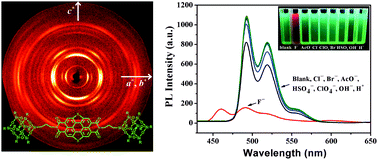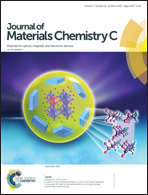Synthesis, crystal structure, enhanced photoluminescence properties and fluoride detection ability of S-heterocyclic annulated perylene diimide-polyhedral oligosilsesquioxane dye†
Abstract
A novel S-heterocyclic annulated perylene diimide (SPDI) derivative connected to two polyhedral oligosilsesquioxane (POSS) nanoparticles was designed and synthesized to reveal the effect of bulky substituent groups on its self-assembly behavior and photoluminescence properties. This featured organic–inorganic hybrid can easily self-assemble into crystalline microbelts with a length of several hundred micrometers. The phase behavior and crystal structure of the compound was then elucidated via a combination of different experimental techniques such as differential scanning calorimetry (DSC), one- and two-dimensional (1D and 2D) X-ray diffraction (XRD), UV/Vis and fluorescence spectra, and tandem mass spectrometry with traveling wave ion mobility separation. The experimental results reveal that the compound has a strong propensity to form a dimer in solution and possesses unique molecular packing of discrete dimeric motifs in the solid state. Moreover, due to this discrete molecular packing behavior, the compound exhibits enhanced photoluminescence properties both in solution and in the solid state compared to the reference compound SPDI without a pendant POSS cage. In addition, based on the dual reactions of electron transfer and fluoride-triggered Si–O bond cleavage, the POSS containing SPDI exhibits higher selectivity and sensitivity to fluoride anions, and a quicker response against the reference SPDI without a pendant POSS cage. The enhanced luminescence properties, and the ability to form ultralong crystalline microbelts, in combination with the rapid selective response for F− make this compound a promising material for the fabrication of luminescent devices and colorimetric chemosensors.



 Please wait while we load your content...
Please wait while we load your content...